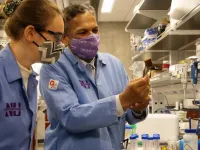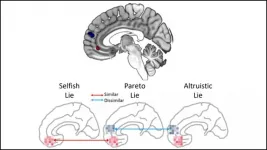(Press-News.org) Below please find summaries of new articles that will be published in the next issue of Annals of Internal Medicine. The summaries are not intended to substitute for the full articles as a source of information. This information is under strict embargo and by taking it into possession, media representatives are committing to the terms of the embargo not only on their own behalf, but also on behalf of the organization they represent.
1. Tai chi about equal to conventional exercise for reducing belly fat in middle-aged and older adults
HD video soundbites of the author discussing the findings are available to download at http://www.dssimon.com/MM/ACP-tai-chi
Abstract: https://www.acpjournals.org/doi/10.7326/M20-7014
URL goes live when the embargo lifts
A randomized controlled trial found that tai chi is about as effective as conventional exercise for reducing waist circumference in middle-aged and older adults with central obesity. Central obesity, or weight carried around the midsection, is a major manifestation of metabolic syndrome and a common health problem in this cohort. The findings are published in Annals of Internal Medicine.
Tai chi is a form of mind-body exercise often described as "meditation in motion." It is practiced in many Asian communities and is becoming increasingly popular in Western countries, with more than 2 million people practicing it in the United States. While it is known to be a suitable activity for older people including those who are not active, there previously has been little evidence on tai chi's health benefits.
Researchers from the University of Hong Kong randomly assigned more than 500 adults over 50 with central obesity to a regimen of tai chi, conventional exercise, or no exercise over 3 months. Participants in the tai chi and exercise groups met for instructor-led workouts for 1 hour 3 times a week for 12 weeks. The tai chi program consisted of the Yang style of tai chi, the most common style adopted in the literature, and the conventional exercise program consisted of brisk walking and strength training activities. Waist circumference and other indicators of metabolic health were measured at baseline, 12 weeks, and 38 weeks. The researchers found that both the tai chi intervention and conventional exercise intervention group had reductions in waist circumference, relative to control. The reduction in waist circumference had a favorable impact on HDL cholesterol, or so-called good cholesterol, but did not translate into detectable differences in fasting glucose or blood pressure.
According to the study authors, their findings are good news for middle-aged and older adults who have central obesity but may be averse to conventional exercise due to preference or limited mobility.
Media contacts: For an embargoed PDF, please contact Angela Collom at acollom@acponline.org. To speak with the corresponding author, Parco M. Siu, PhD, please email pmsiu@hku.hk.
2. COVID-19 disease and cost burden especially high among older adults, particularly those of color
Abstract: https://www.acpjournals.org/doi/10.7326/M21-1102
Editorial: https://www.acpjournals.org/doi/10.7326/M21-2187
URL goes live when the embargo lifts
A retrospective observational study found that the COVID-19 disease burden among adults aged 65 years or older was substantially higher than in the general U.S. population, especially among those of non-White race/ethnicity. The findings are published in Annals of Internal Medicine.
Researchers from the Centers for Disease Control and Prevention (CDC) used Medicare claims data for 28.1 million fee-for-service beneficiaries to examine the characteristics and medical costs of older adults who were diagnosed with COVID-19 from April through December 2020. The data showed that the hospitalization rate was more than 60 times higher, and the mortality rate was 2.5 times higher (4.2%) for older adults compared to the general population. The average cost per COVID-19-related hospitalization was considerable ($21,752) among those older adults, but the costs of COVID-19-related hospitalization decreased with age for the 5 medical outcomes considered. According to the authors, possible reasons include higher mortality rates among older patients, resulting in shorter hospital stays and lower costs (inpatient length of stay was shorter among patients aged ?75 years than among those aged 65 to 74 years); the lower likelihood of younger adults to become seriously ill (those who reached the point of hospitalization may have had substantial risks and complications); and less aggressive care with increasing age.
The data also showed that people of color accounted for a disproportionate share of hospitalizations and deaths during the pandemic. Black, Hispanic, and Asian/Pacific Islander older adults had higher probability of death and receiving ventilator support during hospitalization than non-Hispanic White patients. This finding highlights the importance of identifying effective strategies to promote COVID-19 vaccine uptake among non-White persons aged 65 years or older to mitigate the increased disease and economic burden.
Media contacts: For an embargoed PDF, please contact Angela Collom at acollom@acponline.org. To speak with the corresponding author, Yuping Tsai, PhD, please contact Kristen Nordlund at hok4@cdc.gov.
3. Financial penalties not associated with improvements in quality of outpatient dialysis centers
Abstract: https://www.acpjournals.org/doi/10.7326/M20-6662
URL goes live when the embargo lifts
An observational study found that performance-based financial penalties under the Centers for Medicare & Medicaid Services (CMS) End-Stage Renal Disease Quality Incentive Program (ESRD-QIP) were not associated with improvement in the quality of outpatient dialysis centers. The penalties also did not seem to affect any of the individual outcome measures studied. The findings are published in Annals of Internal Medicine.
There are 500,000 patients on dialysis in the United States today. CMS spends about $100,000 per person/year for patients on dialysis, which is about 6-7% of the total Medicare budget and almost 1% of the total federal government budget. In 2012, the CMS started levying performance-based financial penalties against outpatient dialysis centers under the mandatory ESRD-QIP program. For many reasons, including the complexity of the program, it's effect on quality has never been measured.
Researchers from the Center for Healthcare Outcomes and Policy and the University of Michigan studied publicly available Medicare data to determine whether penalization was associated with improvement in dialysis center quality. The data showed that 1,109 (19.0%) outpatient dialysis centers received penalties in 2017 based on performance in 2015. Penalization was not associated with improvement in total performance scores in 2017 or 2018. This was consistent across a range of different types of centers and individual quality metrics included in the program's total performance score. According to the authors, these findings are significant because they can help Medicare improve the program, which has broad implications for the quality of outpatient dialysis in the United States.
Media contacts: For an embargoed PDF, please contact Angela Collom at acollom@acponline.org. To speak with the corresponding author, Kyle H. Sheetz, MD, MSc, please contact Kara Gavin at kegavin@med.umich.edu.
INFORMATION:
Also new in this issue:
Medical Schools as Racialized Organizations
Nguemeni Tiako
Academia and the Profession
Abstract: https://www.acpjournals.org/doi/10.7326/M21-0369
SGLT-2 Revisited: Diabetes Management in Chronic Kidney Disease
Centor
Annals On Call
Abstract: https://www.acpjournals.org/doi/10.7326/A20-0014
UCLA HEALTH RESEARCH BRIEF
FINDINGS
A new study shows that tai chi mirrors the beneficial effects of conventional exercise by reducing waist circumference in middle-aged and older adults with central obesity. The study was done by investigators at the University of Hong Kong, The Chinese University of Hong Kong; Chinese Academy of Sciences; and UCLA.
BACKGROUND
Central obesity is a major manifestation of metabolic syndrome, broadly defined as a cluster of cardiometabolic risk factors, including central obesity, dyslipidemia, hyperglycemia, low high-density lipoprotein ...
A new study published in Proceedings of National Academics of Sciences finds that individuals who falsely believe they are able to identify false news are more likely to fall victim to it. In the article published today, Ben Lyons, assistant professor of communication at the University of Utah, and his colleagues examine the concern about the public's susceptibility to false news due to their inability to recognize their own limitations in identifying such information.
"Though Americans believe confusion caused by false news is extensive, relatively few indicate having seen or shared it," said Lyons. "If people incorrectly see themselves as highly skilled at identifying false news, they may unwittingly be more likely to consume, believe and share it, especially if it conforms to their ...
Phosphate pollution in rivers, lakes and other waterways has reached dangerous levels, causing algae blooms that starve fish and aquatic plants of oxygen. Meanwhile, farmers worldwide are coming to terms with a dwindling reserve of phosphate fertilizers that feed half the world's food supply.
Inspired by Chicago's many nearby bodies of water, a Northwestern University-led team has developed a way to repeatedly remove and reuse phosphate from polluted waters. The researchers liken the development to a "Swiss Army knife" for pollution remediation as they tailor their membrane to absorb ...
Very high atmospheric CO2 levels can explain the high temperatures on the still young Earth three to four billion years ago. At the time, our Sun shone with only 70 to 80 per cent of its present intensity. Nevertheless, the climate on the young Earth was apparently quite warm because there was hardly any glacial ice. This phenomenon is known as the 'paradox of the young weak Sun.' Without an effective greenhouse gas, the young Earth would have frozen into a lump of ice. Whether CO2, methane, or an entirely different greenhouse gas heated up planet Earth is a matter of debate among scientists. New research by Dr ...
Art Garfunkel once described his legendary musical chemistry with Paul Simon, "We meet somewhere in the air through the vocal cords ... ." But a new study of duetting songbirds from Ecuador, the plain-tail wren (Pheugopedius euophrys), has offered another tune explaining the mysterious connection between successful performing duos.
It's a link of their minds, and it happens, in fact, as each singer mutes the brain of the other as they coordinate their duets.
In a study published May 31 in Proceedings of the National Academy of Sciences, a team of researchers studying brain ...
Three groups (Dr. James Birchler's group from University of Missouri, Dr. Jan Barto's group from Institute of Experimental Botany of the Czech Academy of Sciences and Dr. HAN Fangpu's group from the Institute of Genetics and Developmental Biology of the Chinese Academy of Sciences) recently reported a reference sequence for the supernumerary B chromosome in maize in a study published online in PNAS (doi:10.1073/pnas.2104254118).
Supernumerary B chromosomes persist in thousands of plant and animal genomes despite being nonessential. They are maintained in populations by mechanisms of "drive" that make them inherited at higher than typical Mendelian rates. Key properties such as its origin, evolution, and the molecular mechanism for its accumulation in ...
While it is widely accepted that climate change drove the evolution of our species in Africa, the exact character of that climate change and its impacts are not well understood. Glacial-interglacial cycles strongly impact patterns of climate change in many parts of the world, and were also assumed to regulate environmental changes in Africa during the critical period of human evolution over the last ~1 million years. The ecosystem changes driven by these glacial cycles are thought to have stimulated the evolution and dispersal of early humans.
A paper published in Proceedings of the National Academy of Sciences of the United States of America (PNAS) this week challenges this view. Dr. Kaboth-Bahr ...
The Sahara has not always been covered by only sand and rocks. During the period from 14,500 to 5,000 years ago large areas of North Africa were more heavily populated, and where there is desert today the land was green with vegetation. This is evidenced by various sites with rock paintings showing not only giraffes and crocodiles, but even illustrating people swimming in the "Cave of Swimmers". This period is known as the Green Sahara or African Humid Period. Until now, researchers have assumed that the necessary rain was brought from the tropics through an enhanced summer monsoon. The northward shift of the monsoon was attributed to rotation of the Earth's tilted axis that produces higher levels of ...
An emotion regulation strategy known as cognitive reappraisal helped reduce the typically heightened and habitual attention to drug-related cues and contexts in cocaine-addicted individuals, a study by Mount Sinai researchers has found. In a paper published in PNAS, the team suggested that this form of habit disruption, mediated by the prefrontal cortex (PFC) of the brain, could play an important role in reducing the compulsive drug-seeking behavior and relapse that are the hallmarks, and long-standing challenges, of addiction.
"Relapse in addiction is often precipitated by heightened attention-bias to drug-related cues, which could consist of sights, smells, ...
You may think a little white lie about a bad haircut is strictly for your friend's benefit, but your brain activity says otherwise. Distinct activity patterns in the prefrontal cortex reveal when a white lie has selfish motives, according to new research published in JNeurosci.
White lies -- formally called Pareto lies -- can benefit both parties, but their true motives are encoded by the medial prefrontal cortex (MPFC). This brain region computes the value of different social behaviors, with some subregions focusing on internal motivations and others on external ones. Kim and Kim predicted activity patterns in these subregions could elucidate the true motive behind white lies.
The research team deployed a stand in for white lies, having participants tell lies to earn a reward ...





